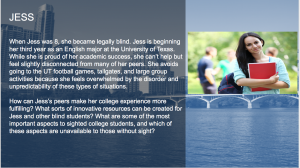This week Design For America spoke to us about design thinking and conducted a workshop. This organization works together to create new solutions to problems. They talked us through their six-step process. We learned that identifying a need is an essential step. It is the first step that will lead into immersing, reframing, ideating, building, and testing. This class period was extremely hands on and active because we solved our own problem. The Design For America team walked us through each step and allocated time for us to brainstorm.

We were trying to help Jess, a blind college student, feel more comfortable at school. My group tried to imagine Jess’s world. We thought the social aspect would be the most difficult because in college it is important to meet friends and be apart of the college sports. Football games are a really big part of the college experience and football stadiums can be dangerous. We created an idea of putting pegs on the stairwell and stairs for Jess to navigate. This way at games she can figure out where she is walking and be cautious. We found safety to be most important for Jess.

This brainstorming strategy taught me to be patient and build on ideas. Your first idea is not always going to be your end goal. It is important to start with one idea and develop it into your final project. They gave us post-it notes and told us to use as many as we want. I really liked this because you were able to organize your thoughts on paper. At the end, we put them on a large piece of paper and were able to connect all our steps together. I am a visual person so this design-thinking workshop worked well for me.
This process will be helpful for our final project. I read an article about Mark Zuckerberg creating Facebook. Facebook was first called Thefacebook and he developed it into the site it is now. This is an example of Zuckerberg reframing, building, and testing an idea. I am excited to use what I learned this week for our project.

I really enjoyed how you touched on the aspect of building on ideas. Something I have been struggling with over the past few weeks while trying to think of a project is that I think I need to come up with a brilliant idea without any prior research or knowledge. This week made me realize it takes a lot of thinking before your end product to come up with something that is actually useful to people in the community. I am hoping this will help me as my team and I try to develop a good idea for our final project.
Hey Bridget,
I really enjoyed your post this week. My group also selected Jess for the DFA workshop. We went through a similar process of really understanding our user and the problem at hand before thinking about a solution. I also agree with you that this class was one of the more hands on lectures. I thought I learned a lot about design thinking and is applications this past week. I hope to continue utilizing the design thinking process moving forward in class!
Hey Bridget,
Looks like we had a lot of similar takeaways from this week’s in-class experience. The design thinking framework that you posted is quite similar to mine, taking us through the process from problem to solution. In designing our solutions, it was cool to see how many different products we came up with for Jess as a group. As a result, we see that there are infinitely many ways to solve a problem. Design thinking – if done flawlessly – will ensure that we solve Jess’s problem in the most effective way possible.
Hi Bridget,
I agree- your first idea will not necessarily be your end goal. I liked the fact that the DFA speakers taught us to start with the problems a student may face before ever considering solutions that could help to improve their lives.
I remember your solution for Jess, the pegs on the stairwells. I think this solution would be greatly helpful, not only for Jess, but for all people with varying levels of blindness who are nonetheless trying to enjoy a football game.